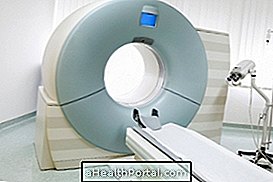Magnetic Resonance Imaging (MRI) is an imaging test capable of showing the internal structures of the organs and is important for diagnosing various health problems such as aneurysms, tumors, changes in the joints or other injuries to internal organs.
To do the test, a large machine is used, which creates the high definition images of the internal organs through the use of a magnetic field, which causes a shake of the molecules of the body, captured by the device and transferred to a computer. The test lasts for about 15 to 30 minutes and usually does not require any preparation, although contrast may be required in some cases by injecting the drug into the vein.


Price
MRI is done only with the medical indication, and there are no costs when made by SUS. When done privately, this exam can cost a value between $ 800 and $ 1500.00, depending on the body region to be evaluated in the exam and the clinic where it is done.
What is it for
Magnetic resonance imaging is indicated in the following cases:
- Identify neurological diseases, such as Alzheimer's, brain tumor, multiple sclerosis or stroke, for example;
- Observe inflammation or infection in the brain, nerves, or joints;
- Diagnose musculoskeletal injuries, such as tendinitis, ligament injuries, cysts, such as Tarlov's cyst or disc hernias, for example;
- Identify masses or tumors in the organs of the body;
- Observe changes in blood vessels, such as aneurysms or clots.
Some care must be taken prior to this examination, as there can be no metallic material near the magnetic field of the apparatus, such as hair clips, glasses or clothing details, thus avoiding accidents. For this reason, this test is contraindicated for people who have any type of prosthesis, pacemaker or metallic pins implanted in the body.
Besides the good quality of the images formed by the magnetic resonance, another advantage is the non-use of ionizing radiation to obtain the results, different from the computed tomography. Understand what it is for and when a CT scan is needed.

How is it done?
Magnetic resonance imaging usually lasts for 15 to 30 minutes, lasting up to 2 hours depending on the area being examined. For its accomplishment it is necessary to remain inside the apparatus that emits the magnetic field, and does not hurt, however, it is very important not to move during this period, since any movement can alter the quality of the examination.
In people who can not stand still, such as children, with claustrophobia, dementia, or schizophrenia, for example, sedation may be necessary to induce sleep, otherwise the test may not be effective.
In addition, in some cases, it may be necessary to apply a contrast in the patient's vein, such as gallium, as it is a way of causing more definition of the images, especially to view organs or blood vessels.
Types of MRI
Magnetic resonance imaging depends on the affected site, and the most common types include:
- Magnetic resonance imaging of the pelvis, abdomen, or chest: for diagnosing tumors or masses in organs such as uterus, intestines, ovaries, prostate, bladder, pancreas, or heart, for example;
- Magnetic resonance imaging of the skull: helps evaluate brain malformations, internal bleeding, cerebral thrombosis, brain tumors and other changes or infections in the brain or in your veins;
- Magnetic resonance imaging of the spine helps to diagnose problems in the spine and spinal cord, such as tumors, calcifications, or fragments of bones after fractures - See how to identify arthrosis in the spine, for example;
- Magnetic resonance imaging of joints, such as the shoulder, knee, or ankle: serves to assess soft tissues within the joint, such as the bursa, tendons, and ligaments.
Magnetic resonance imaging is therefore an excellent examination to observe the soft parts of the body; however, it is not usually indicated to observe lesions in rigid regions, such as bones, and in these cases, it is more appropriate to perform examinations such as x-ray or computed tomography, for example.


























